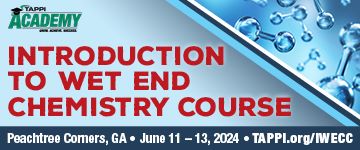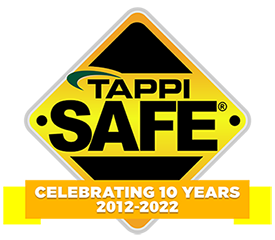 Search
Search
Use the search bar or filters below to find any TAPPI product or publication.
Filters
Content Type
Publications
Level of Knowledge
Collections
Journal articles

Magazine articles

Effects of orders of addition in nanocellulose•cationic starch• colloidal silica systems for papermaking, TAPPI Journal October 2022
ABSTRACT: Two orders of addition were compared when preparing paper handsheets from recycled copy paper furnish in combination with nanofibrillated cellulose (NFC), cationic starch, colloidal silica, and cationic retention aid (cPAM; cationic polyacrylamide). Faster dewatering and higher fine-particle retention were obtained at equal optimized dosages of additives when the colloidal silica was added last, after addition of the cPAM. The same order of addition also provided a higher gain in the paper’s tensile strength. However, higher paper stiffness was achieved when the colloidal silica was instead added to the NFC, after its pretreatment with cationic starch. Results were consistent with the principle that papermaking additives added shortly before sheetforming tend to have the largest effects on drainage and retention. The results also demonstrated a sensitivity to the relative dosages of positively and negatively charged additives.
Journal articles

TAPPIâ??s International Nanotechnology Division Ballots, First Cellulose Nanomaterials Standard, Paper360° March/April 2013
Nanotechnology, Paper360º March/April 2013
Journal articles

Magazine articles

Papermaking properties of bacterial nanocellulose produced from mother of vinegar, a waste product after classical vinegar production, TAPPI Journal April 2020
ABSTRACT: Bacterial nanocellulose (BNC) has gained a lot of attention in recent years due to its nano-size-derived properties. Although it is essentially chemically similar to plant-derived cellulose, it has smaller size and is enriched in free hydroxyl groups, which greatly improve mechanical properties of reinforced paper. However, although BNC has some unique features, it comes at a high price. In this paper, we introduce a new solution for BNC production. We have isolated bacterial nanocellulose directly from agro-industrial waste—mother of vinegar—and used it in the production of paper sheets. We show here that paper sheets made with the addition of only 10% bacterial nanocellulose from mother of vinegar substantially improved basic mechanical as well as printing properties of paper.
Journal articles

Mechanistic aspects of microparticle systems, TAPPI JOURNAL, November 2005, Vol. 4(11) (168 KB)
Mechanistic aspects of microparticle systems, TAPPI JOURNAL, November 2005, Vol. 4(11) (168 KB)
Journal articles

Prioritization for an r&t program: tools that help to achieve consensus, TAPPI JOURNAL, July 2001, Vol. 84(7)
Prioritization for an r&t program: tools that help to achieve consensus, TAPPI JOURNAL, July 2001, Vol. 84(7)
Journal articles

Guest Editorial: Forest products: The nanocellulosics frontier, TAPPI JOURNAL April 2011
Guest Editorial: Forest products: The nanocellulosics frontier, TAPPI JOURNAL April 2011
Journal articles

New Nanoparticle Laytex Offers Natural Advantage, Paper360º, January 2007
A Natural Approach, Paper360º, January 2007
Journal articles

Magazine articles

We’ve Got Good Chemistry: Innovations Papermakers Need to Know About, Paper360º March/April 2020
We’ve Got Good Chemistry: Innovations Papermakers Need to Know About, Paper360º March/April 2020
Journal articles

Magazine articles

TAPPI Journal Summaries, Paper360º May/June 2020
TAPPI Journal Summaries, Paper360º May/June 2020
Journal articles

Conductive elastic 3D printed composites based on nanocellulose for controlled drug release, 20 NANO Virtual Conference
Conductive elastic 3D printed composites based on nanocellulose for controlled drug release, 20 NANO Virtual Conference






